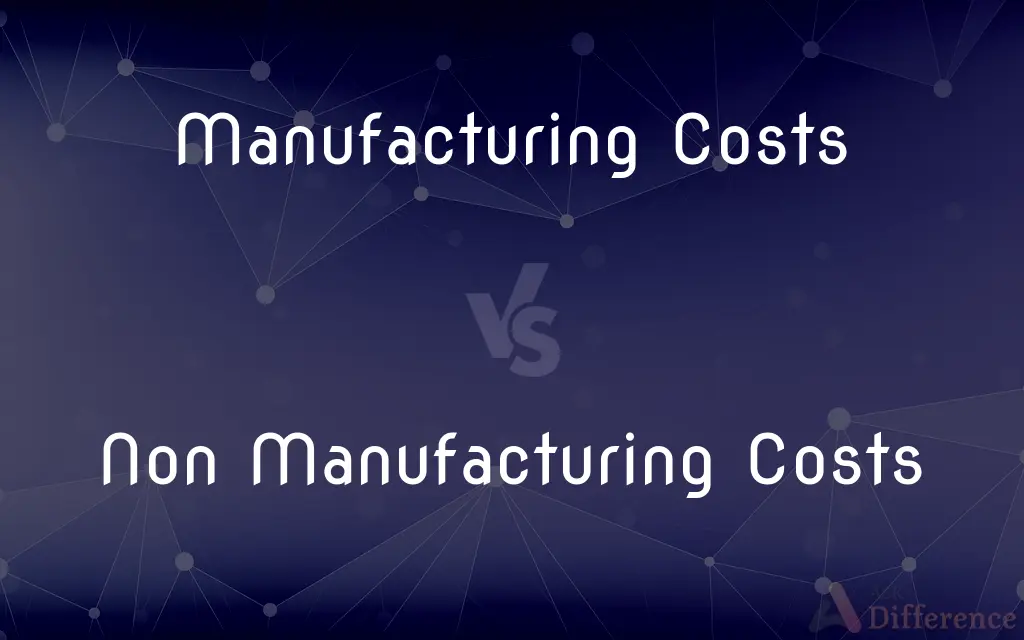Manufacturing Costs vs. Non Manufacturing Costs — What's the Difference?
By Tayyaba Rehman — Published on October 8, 2023
Manufacturing Costs are expenses directly related to producing goods, including raw materials, labor, and overhead; Non-Manufacturing Costs are indirect costs, like sales, administration, and marketing expenses.

Difference Between Manufacturing Costs and Non Manufacturing Costs
Table of Contents
ADVERTISEMENT
Key Differences
Manufacturing Costs and Non-Manufacturing Costs are pivotal aspects in cost accounting and business operations. Manufacturing Costs refer to all the costs that are directly related to the production of goods. These typically include the costs of raw materials, labor used in the production, and manufacturing overhead. This forms the bedrock of cost for manufacturing companies, dictating the cost structure and subsequently, the pricing of the products. Non-Manufacturing Costs, in contrast, are those costs that are not directly associated with the production of goods. These costs primarily include selling, general, and administrative expenses.
Understanding the nuances between Manufacturing Costs and Non-Manufacturing Costs is crucial as it impacts product pricing, cost management, and overall profitability of a business. Manufacturing Costs are inherently variable, fluctuating with the level of production, whereas many Non-Manufacturing Costs tend to be fixed, remaining constant regardless of the production level. This distinction becomes pivotal during cost-volume-profit analysis, helping businesses in pricing strategies and operational planning.
Manufacturing Costs play a crucial role in inventory valuation and are capitalized as part of inventory until the goods are sold, impacting the balance sheet and income statement simultaneously. Non-Manufacturing Costs, however, are treated as period costs and are expensed in the period they are incurred, predominantly impacting the income statement. Discerning between the two is imperative for accurate financial reporting and analysis.
Additionally, accurate allocation of Manufacturing Costs is critical for determining product cost, which subsequently impacts the pricing and competitiveness of the product in the market. On the other hand, effective management of Non-Manufacturing Costs is vital for controlling operational expenses and maintaining the overall profitability of the business, especially in the service and retail sectors where such costs are predominant.
Comparison Chart
Nature
Direct costs related to producing goods.
Indirect costs like administrative and marketing costs.
ADVERTISEMENT
Variability
Mostly variable with production levels.
Many are fixed, not related to production levels.
Impact Area
Affect product pricing and inventory valuation.
Impact operational expenses and overall profitability.
Treatment in Accounting
Capitalized as part of inventory until goods are sold.
Expensed in the period they are incurred.
Relevance
Crucial for manufacturing companies.
Predominant in service and retail sectors.
Compare with Definitions
Manufacturing Costs
Manufacturing Costs include costs of raw materials, labor, and overhead.
The company initiated efficiency measures to reduce Manufacturing Costs.
Non Manufacturing Costs
Non-Manufacturing Costs are predominant in the service and retail sectors.
In service-oriented businesses, controlling Non-Manufacturing Costs is often a priority.
Manufacturing Costs
Manufacturing Costs are the direct costs involved in producing goods.
The increase in raw material prices elevated the Manufacturing Costs for the company.
Non Manufacturing Costs
Non-Manufacturing Costs are not directly related to the production of goods.
The company’s Non-Manufacturing Costs included marketing and administrative expenses.
Manufacturing Costs
Manufacturing Costs vary with the level of production.
The company aimed to optimize Manufacturing Costs by balancing production levels.
Non Manufacturing Costs
Non-Manufacturing Costs primarily consist of selling, general, and administrative expenses.
A reduction in Non-Manufacturing Costs contributed to the company’s increased profitability.
Manufacturing Costs
Manufacturing Costs impact the cost structure and pricing of products.
Competitive Manufacturing Costs enabled the company to offer products at competitive prices.
Non Manufacturing Costs
Non-Manufacturing Costs are treated as period costs and expensed when incurred.
The company aimed to maintain a balance in Non-Manufacturing Costs each financial period.
Manufacturing Costs
Manufacturing Costs are capitalized as part of inventory until the goods are sold.
Accurate allocation of Manufacturing Costs is crucial for proper inventory valuation.
Non Manufacturing Costs
Non-Manufacturing Costs impact overall operational expenses and profitability.
Effective management of Non-Manufacturing Costs is vital for sustaining profitability.
Common Curiosities
What are Non-Manufacturing Costs?
They are indirect costs not related to production, including selling, administrative, and marketing expenses.
What are Manufacturing Costs?
They are the direct costs associated with producing goods, including raw materials, labor, and overhead.
How are Manufacturing Costs treated in accounting?
They are capitalized as part of inventory until the goods are sold.
Why are Manufacturing Costs crucial for manufacturing companies?
They dictate the cost structure, impact product pricing, and affect inventory valuation and profitability.
Can reduction in Non-Manufacturing Costs increase profitability?
Yes, controlling Non-Manufacturing Costs can significantly enhance overall profitability.
Are Non-Manufacturing Costs included in income statements?
Yes, they predominantly impact the income statement as they are expensed in the period incurred.
How are Non-Manufacturing Costs treated in accounting?
They are expensed in the period they are incurred.
Do Manufacturing Costs impact product pricing?
Yes, they directly impact the cost structure and subsequently the pricing of products.
How do Non-Manufacturing Costs impact service and retail sectors?
They are predominant in these sectors and impact operational expenses and overall profitability.
Are Manufacturing Costs included in cost of goods sold (COGS)?
Yes, once the goods are sold, Manufacturing Costs are included in COGS.
Can efficient management of Manufacturing Costs offer competitive advantage?
Yes, it can enable companies to offer products at competitive prices, gaining a market advantage.
Are Non-Manufacturing Costs variable with production levels?
No, many Non-Manufacturing Costs tend to be fixed and do not vary with production levels.
Can Manufacturing Costs be variable and fixed?
Yes, while many are variable with production, some like manufacturing overhead can be fixed.
Is it important to accurately allocate Manufacturing Costs?
Yes, accurate allocation is vital for correct inventory valuation and financial reporting.
Can high Non-Manufacturing Costs lead to operational inefficiency?
Yes, uncontrolled Non-Manufacturing Costs can signify operational inefficiency and reduce profitability.
Share Your Discovery

Previous Comparison
Fire Insurance vs. Marine Insurance
Next Comparison
Prevention vs. InterventionAuthor Spotlight
Written by
Tayyaba RehmanTayyaba Rehman is a distinguished writer, currently serving as a primary contributor to askdifference.com. As a researcher in semantics and etymology, Tayyaba's passion for the complexity of languages and their distinctions has found a perfect home on the platform. Tayyaba delves into the intricacies of language, distinguishing between commonly confused words and phrases, thereby providing clarity for readers worldwide.
















































